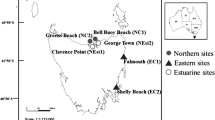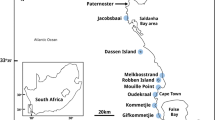Abstract
Laminaria pallida and Ecklonia maxima are large, commercially valuable kelps that co-dominate inshore waters of the west coast of Southern Africa in a geographically changing pattern. In the south, E. maxima dominates and forms a canopy in shallow waters (< about 5 m deep), with L. pallida forming a sub-canopy and extending down to 20 m or more. Northward along the Southern African coast and into Namibia, E. maxima is progressively replaced by L. pallida. Corresponding with this change in dominance, L. pallida shows certain morphological changes along the south-to-north geographical gradient. To explain these phenomena, we examined a range of morphological characters in both kelps (stipe length, stipe weight, stipe outer diameter, stipe inner diameter, length of hollow section in the stipe, and frond weight), and various environmental factors (seawater temperature, seawater turbidity, cloud/fog data, daylength, and wave and wind data). Our results, based on measurements at seven sites along 1600 km of coast between Cape Town and Swakopmund (Namibia), quantified and confirmed the change in dominance and the northward increase in stipe hollowness in L. pallida. The morphology of E. maxima did not change with latitude. Water turbidity, wind speed, and wave height differed significantly along the coast. However, only turbidity showed a steady trend, increasing northward in terms of all indicators (chlorophyll a, particulate inorganic carbon, particulate organic carbon) while wind speed and wave height showed a generally decreasing trend. Furthermore, the hollowness of L. pallida was also not related to the flexibility of the stipes. Our results suggest that L. pallida sporophytes may progressively outcompete E. maxima northward, perhaps because they are more low-light tolerant, and we suggest that by developing a hollow stipe, the sporophytes may grow faster in length, potentially increasing their competitive advantage in the shallow water where they must compete with sporophytes of E. maxima.






Similar content being viewed by others
References
Anderson RJ, Bolton JJ (1985) Suitability of the agarophyte Suhria vittata (L.) J. Ag. (Rhodophyta: Gelidiaceae) for mariculture: geographical distribution, reproductive phenology and growth of sporelings in culture in relation to light and temperature. S Afr J Mar Sci 3:169–178
Anderson RJ, Carrick P, Levitt G, Share A (1997) Holdfasts of adult kelp Ecklonia maxima provide refuges from grazing for recruitment of juvenile kelps. Mar Ecol Prog Ser 159:265–273
Anderson RJ, Rand A, Rothman MD, Share A, Bolton JJ (2007) Mapping and quantifying the South African kelp resource. Afr J Mar Sci 29:369–378
Andrews W, Hutchings L (1980) Upwelling in the southern Benguela Current. Prog Oceanogr 9:1–81
Berger W, Wefer G (2002) On the reconstruction of upwelling history: Namibia upwelling in context. Mar Geol 180:3–28
Bhandari V (2010) Design of machine elements. Tata McGraw-Hill Education Private Limited, Delhi, 930 pp
Blinn JF (1982) Light reflection functions for simulation of clouds and dusty surfaces. ACM SIGGRAPH Comp Graph 16(3):21–29
Bolton JJ, Anderson RJ (1987) Temperature tolerances of two southern African Ecklonia species (Alariaceae: Laminariales) and of hybrids between them. Mar Biol 96:293–297
Bolton JJ, Anderson RJ, Smit AJ, Rothman MD (2012) South African kelp moving eastwards: the discovery of Ecklonia maxima (Osbeck) Papenfuss at De Hoop Nature Reserve on the south coast of South Africa. Afr J Mar Sci 34:147–151
Burgess P (2009) Variation in light intensity at different latitudes and seasons, effects of cloud cover, and the amount of direct and diffused light Available at: http://ccfg.org.uk/conferences/downloads/P_Burgess.pdf. Accessed 17 Oct 2016
Chapman ARO (1973) Phenetic variability of stipe morphology in relation to season, exposure, and depth in the non-digitate complex of Laminaria Lamour (Phaeophyta, Laminariales) in Nova Scotia. Phycologia 12:53–57
Chen Z, Hu C, Muller-Karger F (2007) Monitoring turbidity in Tampa Bay using MODIS/Aqua 250-m imagery. Remote Sens Environ 109:207–220
Clarke K, Gorley R (2006) User manual/tutorial. Primer-E Ltd., Plymouth, 93 pp
Demes KW, Pruitt JN, Harley CD, Carrington E (2013) Survival of the weakest: increased frond mechanical strength in a wave-swept kelp inhibits self-pruning and increases whole-plant mortality. Funct Ecol 27:439–445
Denny M, Gaylord B, Cowen E (1997) Flow and flexibility. II. The roles of size and shape in determining wave forces on the bull kelp Nereocystis luetkeana. J Exp Biol 200:3165–3183
Dieckmann GS (1980) Aspects of the ecology of Laminaria pallida (Grev.) J. Ag. off the Cape Peninsula (South Africa). Bot Mar 23:579–585
Doxaran D, Froidefond J, Castaing P, Babin M (2009) Dynamics of the turbidity maximum zone in a macrotidal estuary (the Gironde, France): observations from field and MODIS satellite data. Estuar Coast Shelf Sci 81:321–332
Field JG, Griffiths CL, Griffiths RJ, Jarman N, Zoutendyk NP, Velimirov B, Bowes A (1980) Variation in structure and biomass of kelp communities along the South-west Cape coast. Trans Roy Soc S Afr 44:145–203
Fowler-Walker MJ, Wernberg T, Connell SD (2006) Differences in kelp morphology between wave sheltered and exposed localities: morphologically plastic or fixed traits? Mar Biol 148:755–767
Friedland MT, Denny MW (1995) Surviving hydrodynamic forces in a wave-swept environment: consequences of morphology in the feather boa kelp, Egregia menziesii (Turner). J Exp Mar Biol Ecol 190:109–133
Gaylord B, Denny M (1997) Flow and flexibility. I. Effects of size, shape and stiffness in determining wave forces on the stipitate kelps Eisenia arborea and Pterygophora californica. J Exp Biol 200:3141–3164
Hornik V (2014) Windguru http://www.windguru.cz/int/
Hurd CL, Pilditch CA (2011) Flow-induced morphological variation affect diffusion boundary-layer thickness of Macrocystis pyrifera (Heterokontophyta, Laminariales). J Phycol 47:341–351
Izquierdo J, Pérez-Ruzafa IM, Gallardo T (2002) Effect of temperature and photon fluence rate on gametophytes and young sporophytes of Laminaria ochroleuca Pylaie. Helgol Mar Res 55:285–292
Jarman NT, Carter R (1981) The primary producers of the inshore regions of the Benguela. Trans Roy Soc S Afr 44:321–326
Jerlov N (1977) Classification of sea water in terms of quanta irradiance. J Conseil 37(3):281–287
Klochkova TA, Kim GH, Lee KM, Choi H, Belij MN, Klochkova NG (2010) Brown algae (Phaeophyceae) from Russian far eastern seas: re-evaluation of Laminaria multiplicata Petrov et Suchovejeva. Algae 25:77–87
Koehl M (1986) Seaweeds in moving water: form and mechanical function. In: Givnish TJ (ed) On the economy of plant form and function. Cambridge Univ. Press, Cambridge, pp 603–634
Lüning K, Dring M (1972) Reproduction induced by blue light in female gametophytes of Laminaria saccharina. Planta 104:252–256
Lüning K (1990) Seaweeds: their environment, biogeography, and scophysiology. Wiley-Interscience, New York, 527pp
Marins BV, Amado-Filho GM, Barreto MB, Longo LL (2012) Taxonomy of the southwestern Atlantic endemic kelp: Laminaria abyssalis and Laminaria brasiliensis (Phaeophyceae, Laminariales) are not different species. Phycol Res 60:51–60
Mann K, Jarman N, Dieckmann G (1979) Development of a method for measuring the productivity of the kelp Ecklonia maxima (Osbeck) Papenfuss. Trans R Soc S Afr 44:27–41
Matson PG, Edwards MS (2006) Latitudinal variation in stipe hollowing in Eisenia arborea (Phaeophyceae, Laminariales). Phycologia 45:343–348
Molloy FJ, Bolton JJ (1990) Utilized and potentially utilizable seaweeds on the Namibian coast: biogeography and accessibility. Hydrobiologia 204/205:293–299
Molloy FJ, Bolton JJ (1996) The effects of wave exposure and depth on the morphology of inshore populations of the Namibian kelp, Laminaria schinzii Foslie. Bot Mar 39:525–531
Monteiro P, Largier J (1999) Thermal stratification in Saldanha Bay (South Africa) and subtidal, density-driven exchange with the coastal waters of the Benguela upwelling system. Estuar Coast Shelf Sci 49:877–890
Muñoz V, Hernández-González MC, Buschmann AH, Graham M, Vásquez J (2004) Variability in per capita oogonia and sporophyte production from giant kelp gametophytes (Macrocystis pyrifera, Phaeophyceae). Rev Chil Hist Nat 77:639–647
National Aeronautics and Space Administration, Moderate resolution image spectroradiometer: http://modis.gsfc.nasa.gov. Accessed 3 Feb 2014
Nelson G, Hutchings L (1983) The Benguela upwelling area. Prog Oceanogr 12:333–356
Norton T, Mathieson A, Neushul M (1982) A review of some aspects of form and function in seaweeds. Bot Mar 25:501–510
Oppliger LV, Correa JA, Engelen AH, Tellier F, Vieira V, Faugeron S, Valero M, Gomez G, Destombe C (2012) Temperature effects on gametophyte life-history traits and geographic distribution of two cryptic kelp species. PLoS One 7:e39289
Petus C, Chust G, Gohin F, Doxaran D, Froidefond J, Sagarminaga Y (2010) Estimating turbidity and total suspended matter in the Adour River plume (South Bay of Biscay) using MODIS 250-m imagery. Cont Shelf Res 30:379–392
Roberson LM, Coyer JA (2004) Variation in blade morphology of the kelp Eisenia arborea: incipient speciation due to local water motion? Mar Ecol Prog Ser 282:115–128
Rothman MD (2006) Investigations into the harvesting ecology of the South African kelp Ecklonia maxima (Alariaceae, Laminariales). Dissertation, University of Cape Town, M.Sc
Rothman MD, Mattio L, Wernberg T, Anderson RJ, Uwai S, Mohring MB, Bolton JJ (2015) A molecular investigation of the genus Ecklonia (Phaeophyceae, Laminariales) with special focus on the Southern Hemisphere. J Phycol 51:236–246
Serisawa Y, Akino H, Matsuyama K, Ohno M, Tanaka J, Yokohama Y (2002) Morphometric study of Ecklonia cava (Laminariales, Phaeophyta) sporophytes in two localities with different temperature conditions. Phycol Res 50:193–199
Serisawa Y, Aoki M, Hirata T, Bellgrove A, Kurashima A, Tsuchiya Y, Toshihiko S, Ueda H, Yokohama Y (2003) Growth and survival rates of large-type sporophytes of Ecklonia cava transplanted to a growth environment with small-type sporophytes. J Appl Phycol 15:311–318
Shannon L (1985) The Benguela ecosystem. I: evolution of the Benguela physical features and processes. Oceanogr Mar Biol 23:105–182
Shannon L, Pillar S (1986) The Benguela ecosystem. Part III. Plankton. Oceanogr Mar Biol Annu Rev 24:65–170
Shirley HL (1929) The influence of light intensity and light quality upon the growth of plants. Am J Bot 16:354–390
Simons RH & Jarman NG (1981) Subcommercial harvesting of a kelp on a South African shore. In: Levring T (ed) Proceedings of the 10th International Seaweed Symposium. pp 731-736
Smale DA, Wernberg T (2009) Satellite-derived SST data as a proxy for water temperature in nearshore benthic ecology. Mar Ecol Prog Ser 387:27–37
Smit AJ, Roberts M, Anderson RJ, Dufois F, Dudley SF, Bornman TG, Olbers J, Bolton JJ (2013) A coastal seawater temperature dataset for biogeographical studies: large biases between in situ and remotely-sensed data sets around the coast of South Africa. PLoS One 8(12):e81944
Stegenga H, Bolton JJ, Anderson RJ (1997) Seaweeds of the South African west coast. Contrib Bolus Herb 18:3–637
Tsutsui I, Arai S, Terawaki T, Ohno M (1996) A morphometric comparison of Ecklonia kurome (Laminariales, Phaeophyta) from Japan. Phycol Res 44:215–222
Utter B, Denny M (1996) Wave-induced forces on the giant kelp Macrocystis pyrifera (Agardh): field test of a computational model. J Exp Biol 199:2645–2654
Velimirov B, Field JG, Griffiths CL, Zoutendyk P (1977) The ecology of kelp bed communities in the Benguela upwelling system. Helgo Meeresun 30:495–518
Velimirov B, Griffiths C (1979) Wave-induced kelp movement and its importance for community structure. Bot Mar 22:169–172
Waldron H, Probyn T (1992) Nitrate supply and potential new production in the Benguela upwelling system. S Afr J Mar Sci 12:29–39
Washington R, Todd M, Middleton NJ, Goudie AS (2003) Dust-storm source areas determined by the total ozone monitoring spectrometer and surface observations. Ann Assoc Am Geol 93:297–313
Wernberg T, Coleman M, Fairhead A, Miller S, Thomsen M (2003) Morphology of Ecklonia radiata (Phaeophyta: Laminarales) along its geographic distribution in south-western Australia and Australasia. Mar Biol 143:47–55
Acknowledgements
This study was supported by the Department of Agriculture, Forestry and Fisheries, South Africa, the University of Cape Town, and the National Research Foundation (NRF). Thank you to Cathy Boucher for the artwork and AJ Smit for the Namibian temperature data. Lastly, thank you to M. Noffke, J. Fridjhon, S. Conrad, D. Williams and S. John for assisting with field work and sample collections.
Author information
Authors and Affiliations
Corresponding author
Rights and permissions
About this article
Cite this article
Rothman, M.D., Bolton, J.J., Stekoll, M.S. et al. Geographical variation in morphology of the two dominant kelp species, Ecklonia maxima and Laminaria pallida (Phaeophyceae, Laminariales), on the west coast of Southern Africa. J Appl Phycol 29, 2627–2639 (2017). https://doi.org/10.1007/s10811-017-1255-7
Received:
Revised:
Accepted:
Published:
Issue Date:
DOI: https://doi.org/10.1007/s10811-017-1255-7




